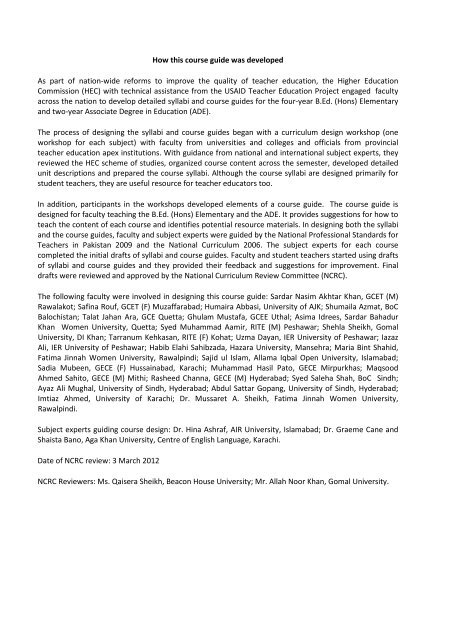Course Guide - USAID Teacher Education Project
Course Guide - USAID Teacher Education Project
Course Guide - USAID Teacher Education Project
You also want an ePaper? Increase the reach of your titles
YUMPU automatically turns print PDFs into web optimized ePapers that Google loves.
How this course guide was developedAs part of nation-wide reforms to improve the quality of teacher education, the Higher <strong>Education</strong>Commission (HEC) with technical assistance from the <strong>USAID</strong> <strong>Teacher</strong> <strong>Education</strong> <strong>Project</strong> engaged facultyacross the nation to develop detailed syllabi and course guides for the four-year B.Ed. (Hons) Elementaryand two-year Associate Degree in <strong>Education</strong> (ADE).The process of designing the syllabi and course guides began with a curriculum design workshop (oneworkshop for each subject) with faculty from universities and colleges and officials from provincialteacher education apex institutions. With guidance from national and international subject experts, theyreviewed the HEC scheme of studies, organized course content across the semester, developed detailedunit descriptions and prepared the course syllabi. Although the course syllabi are designed primarily forstudent teachers, they are useful resource for teacher educators too.In addition, participants in the workshops developed elements of a course guide. The course guide isdesigned for faculty teaching the B.Ed. (Hons) Elementary and the ADE. It provides suggestions for how toteach the content of each course and identifies potential resource materials. In designing both the syllabiand the course guides, faculty and subject experts were guided by the National Professional Standards for<strong>Teacher</strong>s in Pakistan 2009 and the National Curriculum 2006. The subject experts for each coursecompleted the initial drafts of syllabi and course guides. Faculty and student teachers started using draftsof syllabi and course guides and they provided their feedback and suggestions for improvement. Finaldrafts were reviewed and approved by the National Curriculum Review Committee (NCRC).The following faculty were involved in designing this course guide: Sardar Nasim Akhtar Khan, GCET (M)Rawalakot; Safina Rouf, GCET (F) Muzaffarabad; Humaira Abbasi, University of AJK; Shumaila Azmat, BoCBalochistan; Talat Jahan Ara, GCE Quetta; Ghulam Mustafa, GCEE Uthal; Asima Idrees, Sardar BahadurKhan Women University, Quetta; Syed Muhammad Aamir, RITE (M) Peshawar; Shehla Sheikh, GomalUniversity, DI Khan; Tarranum Kehkasan, RITE (F) Kohat; Uzma Dayan, IER University of Peshawar; IazazAli, IER University of Peshawar; Habib Elahi Sahibzada, Hazara University, Mansehra; Maria Bint Shahid,Fatima Jinnah Women University, Rawalpindi; Sajid ul Islam, Allama Iqbal Open University, Islamabad;Sadia Mubeen, GECE (F) Hussainabad, Karachi; Muhammad Hasil Pato, GECE Mirpurkhas; MaqsoodAhmed Sahito, GECE (M) Mithi; Rasheed Channa, GECE (M) Hyderabad; Syed Saleha Shah, BoC Sindh;Ayaz Ali Mughal, University of Sindh, Hyderabad; Abdul Sattar Gopang, University of Sindh, Hyderabad;Imtiaz Ahmed, University of Karachi; Dr. Mussaret A. Sheikh, Fatima Jinnah Women University,Rawalpindi.Subject experts guiding course design: Dr. Hina Ashraf, AIR University, Islamabad; Dr. Graeme Cane andShaista Bano, Aga Khan University, Centre of English Language, Karachi.Date of NCRC review: 3 March 2012NCRC Reviewers: Ms. Qaisera Sheikh, Beacon House University; Mr. Allah Noor Khan, Gomal University.
















